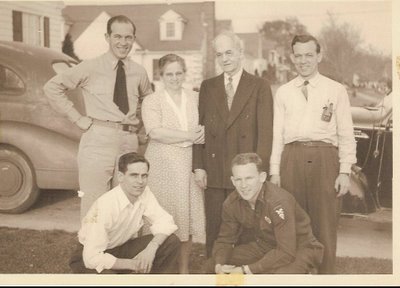 WHO WON THE WAR IN LEBANON
WHO WON THE WAR IN LEBANONI think this article is a nice counterbalance to the news from Lebanon as interpreted by Hezbollah. Just because I’m being fair here does not exactly make me a fan of modern day Israel and all of its policies, but neither do I have a solution to that part of the world’s problems. All I can see is that the average man on the street is taking a hell of a beating over there, and probably, all he/she wants to do is love and support her/his family.
Hezbollah Didn't Win
[OPEN QUOTE] Arab writers are beginning to lift the veil on what really happened in Lebanon.
BY AMIR TAHERI
Friday, August 25, 2006 12:01 a.m. EDT
The way much of the Western media tells the story, Hezbollah won a great victory against Israel and the U.S., healed the Sunni-Shiite rift, and boosted the Iranian mullahs' claim to leadership of the Muslim world. Portraits of Hassan Nasrallah, the junior mullah who leads the Lebanese branch of this pan-Shiite movement, have adorned magazine covers in the West, hammering in the message that this child of the Khomeinist revolution is the new hero of the mythical "Arab Street."
Probably because he watches a lot of CNN, Iran's "Supreme Guide," Ali Khamenei, also believes in "a divine victory." Last week he asked 205 members of his Islamic Majlis to send Mr. Nasrallah a message, congratulating him for his "wise and far-sighted leadership of the Ummah that produced the great victory in Lebanon."
By controlling the flow of information from Lebanon throughout the conflict, and help from all those who disagree with U.S. policies for different reasons, Hezbollah may have won the information war in the West. In Lebanon, the Middle East and the broader Muslim space, however, the picture is rather different.
Let us start with Lebanon.
Immediately after the U.N.-ordained ceasefire started, Hezbollah organized a series of firework shows, accompanied by the distribution of fruits and sweets, to celebrate its victory. Most Lebanese, however, finding the exercise indecent, stayed away. The largest "victory march" in south Beirut, Hezbollah's stronghold, attracted just a few hundred people.
Initially Hezbollah had hesitated between declaring victory and going into mourning for its "martyrs." The latter course would have been more in harmony with Shiite traditions centered on the cult of Imam Hussain's martyrdom in 680 A.D. Some members of Hezbollah wished to play the martyrdom card so that they could accuse Israel, and through it the U.S., of war crimes. They knew that it was easier for Shiites, brought up in a culture of eternal victimhood, to cry over an imagined calamity than laugh in the joy of a claimed victory.
Politically, however, Hezbollah had to declare victory for a simple reason: It had to pretend that the death and desolation it had provoked had been worth it. A claim of victory was Hezbollah's shield against criticism of a strategy that had led Lebanon into war without the knowledge of its government and people. Mr. Nasrallah alluded to this in television appearances, calling on those who criticized him for having triggered the war to shut up because "a great strategic victory" had been won.
The tactic worked for a day or two. However, it did not silence the critics, who have become louder in recent days. The leaders of the March 14 movement, which has a majority in the Lebanese Parliament and government, have demanded an investigation into the circumstances that led to the war, a roundabout way of accusing Hezbollah of having provoked the tragedy. Prime Minister Fuad Siniora has made it clear that he would not allow Hezbollah to continue as a state within the state. Even Michel Aoun, a maverick Christian leader and tactical ally of Hezbollah, has called for the Shiite militia to disband.
Mr. Nasrallah followed his claim of victory with what is known as the "Green Flood"(Al-sayl al-akhdhar). This refers to the massive amounts of crisp U.S. dollar notes that Hezbollah is distributing among Shiites in Beirut and the south. The dollars from Iran are ferried to Beirut via Syria and distributed through networks of militants. Anyone who can prove that his home was damaged in the war receives $12,000, a tidy sum in wartorn Lebanon.
The Green Flood has been unleashed to silence criticism of Mr. Nasrallah and his masters in Tehran. But the trick does not seem to be working. "If Hezbollah won a victory, it was a Pyrrhic one," says Walid Abi-Mershed, a leading Lebanese columnist. "They made Lebanon pay too high a price--for which they must be held accountable."
Hezbollah is also criticized from within the Lebanese Shiite community, which accounts for some 40% of the population. Sayyed Ali al-Amin, the grand old man of Lebanese Shiism, has broken years of silence to criticize Hezbollah for provoking the war, and called for its disarmament. In an interview granted to the Beirut An-Nahar, he rejected the claim that Hezbollah represented the whole of the Shiite community. "I don't believe Hezbollah asked the Shiite community what they thought about [starting the] war," Mr. al-Amin said. "The fact that the masses [of Shiites] fled from the south is proof that they rejected the war. The Shiite community never gave anyone the right to wage war in its name."
There were even sharper attacks. Mona Fayed, a prominent Shiite academic in Beirut, wrote an article also published by An-Nahar last week. She asks: Who is a Shiite in Lebanon today? She provides a sarcastic answer: A Shiite is he who takes his instructions from Iran, terrorizes fellow believers into silence, and leads the nation into catastrophe without consulting anyone. Another academic, Zubair Abboud, writing in Elaph, a popular Arabic-language online newspaper, attacks Hezbollah as "one of the worst things to happen to Arabs in a long time." He accuses Mr. Nasrallah of risking Lebanon's existence in the service of Iran's regional ambitions.
Before he provoked the war, Mr. Nasrallah faced growing criticism not only from the Shiite community, but also from within Hezbollah. Some in the political wing expressed dissatisfaction with his overreliance on the movement's military and security apparatus. Speaking on condition of anonymity, they described Mr. Nasrallah's style as "Stalinist" and pointed to the fact that the party's leadership council (shura) has not held a full session in five years. Mr. Nasrallah took all the major decisions after clearing them with his Iranian and Syrian contacts, and made sure that, on official visits to Tehran, he alone would meet Iran's "Supreme Guide," Ali Khamenei.
Mr. Nasrallah justified his style by claiming that involving too many people in decision-making could allow "the Zionist enemy" to infiltrate the movement. Once he had received the Iranian green light to provoke the war, Mr. Nasrallah acted without informing even the two Hezbollah ministers in the Siniora cabinet or the 12 Hezbollah members of the Lebanese Parliament.
Mr. Nasrallah was also criticized for his acknowledgement of Ali Khamenei as Marjaa al-Taqlid (Source of Emulation), the highest theological authority in Shiism. Highlighting his bay'aah (allegiance), Mr. Nasrallah kisses the man's hand each time they meet. Many Lebanese Shiites resent this because Mr. Khamenei, a powerful politician but a lightweight in theological terms, is not recognized as Marjaa al-Taqlid in Iran itself. The overwhelming majority of Lebanese Shiites regard Grand Ayatollah Ali Sistani, in Iraq, or Ayatollah Muhammad-Hussein Fadhlallah, in Beirut, as their "Source of Emulation."
Some Lebanese Shiites also question Mr. Nasrallah's strategy of opposing Prime Minister Siniora's "Project for Peace," and instead advancing an Iranian-backed "Project of Defiance." The coalition led by Mr. Siniora wants to build Lebanon into a haven of peace in the heart of a turbulent region. His critics dismiss this as a plan "to create a larger Monaco." Mr. Nasrallah's "Project of Defiance," however, is aimed at turning Lebanon into the frontline of Iranian defenses in a war of civilizations between Islam (led by Tehran) and the "infidel," under American leadership. "The choice is between the beach and the bunker," says Lebanese scholar Nadim Shehadeh. There is evidence that a majority of Lebanese Shiites would prefer the beach.
There was a time when Shiites represented an underclass of dirt-poor peasants in the south and lumpen elements in Beirut. Over the past 30 years, however, that picture has changed. Money sent from Shiite immigrants in West Africa (where they dominate the diamond trade), and in the U.S. (especially Michigan), has helped create a prosperous middle class of Shiites more interested in the good life than martyrdom à la Imam Hussain. This new Shiite bourgeoisie dreams of a place in the mainstream of Lebanese politics and hopes to use the community's demographic advantage as a springboard for national leadership. Hezbollah, unless it ceases to be an instrument of Iranian policies, cannot realize that dream.
The list of names of those who never endorsed Hezbollah, or who broke with it after its Iranian connections became too apparent, reads like a Who's Who of Lebanese Shiism. It includes, apart from the al-Amins, families such as the al-As'ad, the Osseiran, the al-Khalil, the Hamadah, the Murtadha, the Sharafeddin, the Fadhlallah, the Mussawis, the Hussainis, the Shamsuddin and the Ata'allahs.
Far from representing the Lebanese national consensus, Hezbollah is a sectarian group backed by a militia that is trained, armed and controlled by Iran. In the words of Hossein Shariatmadari, editor of the Iranian daily Kayhan, "Hezbollah is 'Iran in Lebanon.' " In the 2004 municipal elections, Hezbollah won some 40% of the votes in the Shiite areas, the rest going to its rival Amal (Hope) movement and independent candidates. In last year's general election, Hezbollah won only 12 of the 27 seats allocated to Shiites in the 128-seat National Assembly—despite making alliances with Christian and Druze parties and spending vast sums of Iranian money to buy votes.
Hezbollah's position is no more secure in the broader Arab world, where it is seen as an Iranian tool rather than as the vanguard of a new Nahdha (Awakening), as the Western media claim. To be sure, it is still powerful because it has guns, money and support from Iran, Syria and Hate America International Inc. But the list of prominent Arab writers, both Shiite and Sunni, who have exposed Hezbollah for what it is--a Khomeinist Trojan horse--would be too long for a single article. They are beginning to lift the veil and reveal what really happened in Lebanon.
Having lost more than 500 of its fighters, and with almost all of its medium-range missiles destroyed, Hezbollah may find it hard to sustain its claim of victory. "Hezbollah won the propaganda war because many in the West wanted it to win as a means of settling score with the United States," says Egyptian columnist Ali al-Ibrahim. "But the Arabs have become wise enough to know TV victory from real victory."
Mr. Taheri is author of "L'Irak: Le Dessous Des Cartes" (Editions Complexe, 2002). [CLOSE QUOTE]


















